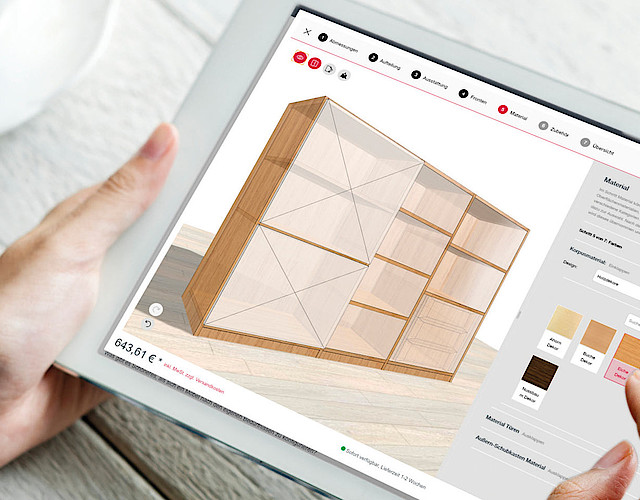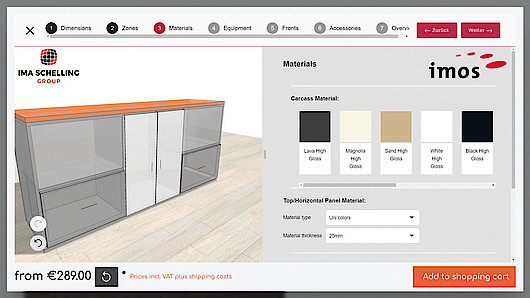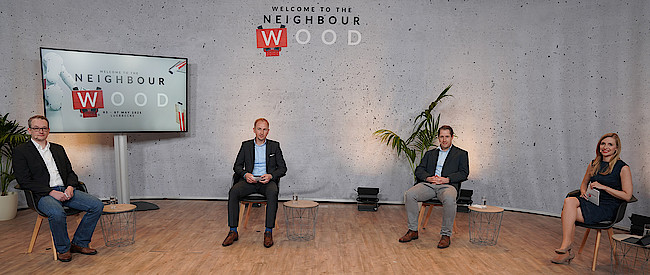

Configuring and ordering individual furniture online is currently trending. To offer the customer a relaxed shopping experience, it is necessary to fully digitalise and automate of the entire process – from data input on the customer’s home PC or tablet, to the production of the furniture, to the delivery of the finished product.
The days of annually published furniture catalogues are well and truly over. New digital possibilities mean the market and available products are changing fast. Individual furniture is in demand. Ideally, it can be configured by the customer themselves via an online configurator and delivered within a few days. But what amounts to a few less clicks for the customer proves to be a highly complex process. It requires a high degree of digitalisation and the optimal interaction of all the systems and organisations involved, as well as excellent process, component and production data.


It all begins with the online configurator on the furniture dealer’s or manufacturer’s website. It provides the design possibilities and selectable options for the respective piece of furniture. As well as the minimum and maximum dimensions, this includes the number and size of the drawers, the door style (hinged, revolving or sliding door, with or without glass, etc.), available handles and decors, and much more. Meanwhile, the configurator must be simple in design, so that the customer can use it intuitively and enjoyably. At the same time, it must provide all the data that will be needed later for production.
“All the above-mentioned data and pricing must be included in the system,” explains Ingo Bathe, Director of International Sales at imos AG.
His company is developing precisely that: a browser-based online shop with a payment system, shopping basket and responsive design that the customer can use to design their own furniture. As well as pricing, imos has built in an automated process that converts the product data provided by the customer into CAD/CAM data for production. The conversion is performed by AI bots or software robots. They also enrich process data with information and forward them to the furniture manufacturer’s ERP system (ERP = Enterprise Resource Planning).
“This means the customer creates the production data automatically when making their purchase,” says Bathe.
The central ERP system, which typically has a modular structure, manages the company’s resources, completes orders and commercial processes, and processes and stores all data in a central database. It also supplies all the necessary data to the downstream MES (Manufacturing Execution System), which is then able to calculate the required production capacities in real time and ensure that the production systems are evenly utilised.
“Once the individually configured cabinet has gone through the customer’s ERP system, that’s where we come in with our software,” says Christian Blaschka, Managing Director of dmaic software GmbH & Co. KG. dmaic provides the interface between the ERP and MES systems, ensuring that the furniture is produced as optimally as possible. To achieve this, the software imports the cabinet data released by the ERP system – including customer orders, work schedules, CAD/CAM data, component identification data, etc. – to the MES system. “At the same time, we create and save digital duplicates of the entire piece of furniture, its assemblies (drawers, doors, carcass, etc.) and its individual parts,” explains Blaschka. Based on the data, the dmaic software also generates the production programs for throughfeed machines and provides the CAD/CAM data for stationary machines.
The digital duplicates and production data stored in the MES are then used to plan the production of the furniture via backward scheduling. “Not every cabinet component needs the same number of work steps or production time. For example, a back wall is much quicker to produce than a door with a cut-out for a glass pane. This is taken into account during planning,” explains Christina Blaschka. A Track & Trace module keeps track of which component is in production in what time and what location. For example, this allows faulty parts to be ejected from the production process, re-finished, and returned to the process at the appropriate juncture. Meanwhile, the software module provides the operator with an overview of production progress and missing parts.

“In the ideal case, data is collected and converted into production data fully automatically, without the intervention of an employee. This requires high-quality data and the precise specification of processes in the system,” says Andreas Dahlmeier, Senior Consultant at IMA Schelling Consulting, adding: “However, that is not the case with every customer that we discuss such projects with.”
Typically, companies use numerous different software solutions with different data inventories. Dahlmeier continues: “Then there is the fact that ERP, MES and CAD/CAM systems are considerably more complex than Excel, for example. That’s why the provision of resources by the customer and working with the customer to establish a process description are absolutely critical to the success of these projects.”

Realising a fully automated value chain, from the online configurator to the delivery of the finished product, demands standardised interfaces, a full picture of the furniture to be produced, complete data and precise process descriptions. Smaller companies in particular would be well-advised to seek the support of a consultant in the optimisation of processes. Last but not least, configuring individual furniture via a manufacturer’s online shop requires highly flexible, fully automated batch-size-one production.
So what could the future look like? Experts agree: VR and AR technologies are becoming increasingly popular in all areas, and customer demand for speed and individuality continues to grow. These demands can only be met with a modular kit of standard software modules, which cuts down the development work and implementation time for new products and processes.